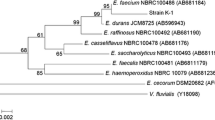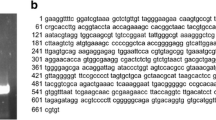Abstract
An Indonesian marine bacterial isolate, which belongs to genus of Bacillus sp. based on 16S rDNA analysis and was identified as Bacillus filicolonicus according to its morphology and physiology, produced a raw starch degrading α-amylase. The partially purified α-amylase using a maize starch affinity method exhibited an optimum pH and temperature of 6.0 and 60°C, respectively. The enzyme retained 72% of its activity in the presence of 1.5 M NaCl. Scanning electron micrographs showed that the α-amylase was capable of degrading starch granules of rice and maize. This α-amylase from Bacillus sp. ALSHL3 was classified as a saccharifying enzyme since its major final degradation product was glucose, maltose, and maltotriose.
Similar content being viewed by others
Abbreviations
- DNSA:
-
dinitrosalicylic acid
- MB:
-
marine broth
- SBD:
-
starch-binding domain
References
Abe A., Tonozuka T., Sakano Y. & Kamitori S. 2004. Complex structures of Thermoactinomyces vulgaris R-47 α-amylase 1 with malto-oligosaccharides demonstrate the role of domain N acting as a starch-binding domain. J. Mol. Biol. 335: 811–822.
Asgher M., Asad M.J., Rahman S.U. & Legge R.L. 2007. A thermostable α-amylase from a moderately thermophilic Bacillus subtilis strain for starch processing. J. Food Eng. 79: 950–955.
Bradford M.M. 1976. A rapid and sensitive method for the quantitation of microgram quantities of protein utilizing the principle of protein-dye-binding. Anal. Biochem. 72: 248–254.
Buchanan R.E., Gibbons N.E., Cowan S.T., Holt J.G., Liston J., Muray R.G.E., Niven C.F., Ravin A.W. & Stanier R.W. 1974. Bergey’s Manual of Determinative Bacteriology, 8th Edition. The Williams and Wilkins Company, Baltimore.
Cho H.Y., Kim Y.W., Kim T.J., Lee H.S., Kim D.Y., Kim J.W., Lee Y.W., Lee S.B. & Park K.H. 2000. Molecular characterization of a dimeric intracellular maltogenic amylase of Bacillus subtilis SUH4-2. Biochim. Biophys. Acta. 1478: 333–340.
Demirkan E.S., Mikami B., Adachi M., Higasa T., Utsumi S. 2005. α-Amylase from B. amyloliquefaciens: purification, characterization, raw starch degradation and expression in E. coli. Process Biochem. 40: 2629–2636.
Fuwa H. 1954. A new method for microdetermination of amylase activity by the use of amylose as a substrate. J. Biochem. 21: 219–230.
Gupta R., Gigras P., Mohapatra H., Goswami V.K. & Chauhan B. 2003. Microbial α-amylases: a biotechnological perspective. Process Biochem. 38: 1599–1616.
Hamilton L.M., Kelly C.T. & Fogarty W.M. 1998. Raw starch degradation by the non-raw starch-adsorbing bacterial α-amylase of Bacillus sp. IMD 434. Carbohydr. Res. 314: 251–257.
Hayashida S., Teramoto Y. & Inoue T. 1988. Production and characteristics of raw potato starch digesting amylase from Bacillus subtilis 65. Appl. Environ. Microbiol. 54: 1516–1522.
Ivanova V., Dobreva E. & Emanuilova E. 1993. Purification and characterization of thermostable α-amylase from Bacillus licheniformis. J. Biotechnol. 28: 277–289.
Janecek S. & Sevcik J. 1999. The evolution of starch-binding domain. FEBS Lett. 456: 119–125.
Kiran K.K. & Chandra T. S. 2008. Production of surfactant and detergent-stable, halophilic, and alkalitolerant α-amylase by a moderately halophilic Bacillus sp. strain TSCVKK. Appl. Microbiol. Biotechnol. 77: 1023–1031.
Laemmli U.K. 1970. Cleavage of structural proteins during the assembly of the head of bacteriphage T4. Nature227: 680–68
Lo H.F., Lin L.L., Chiang W.Y., Chie M.C., Hsu W.H. & Chang C.T. 2002. Deletion analysis of the C-terminal region of the α-amylase of Bacillus sp. strain TS-23. Arch. Microbiol. 178: 115–123.
MacGregor E.A., Janecek S. & Svensson B. 2001. Relationship of sequence and structure to specificity in the α-amylase family of enzymes. Biochim. Biophys. Acta 1546: 1–20.
Machovic M. & Janecek S. 2006. The evolution of putative starch binding domains. FEBS Lett. 580: 6349–6356.
Malhotra R., Noorvez S.M. & Satyanarayana T. 2000. Production and partial characterization of thermostable and calcium independent α-amylase of an extreme thermophile Bacillus thermooleovorans NP54. Lett. Appl. Microbiol. 31: 378–384.
Miller G.L. 1959. Use of dinitrosalicylic acid reagent for determination of reducing sugar. Anal. Chem. 31: 426 428.
Mohapatra B.R., Banerjee U.C. & Bapuji M. 1998. Characterization of a fungal amylase from Mucor sp. associated with the marine sponge Spirastrella sp. J. Biotechnol. 60: 113–117.
Najafi M.F., Deobagkar D. & Deobagkar D. 2005. Purification and characterization of an extracellular α-amylase from Bacillus subtilis AX20. Protein Expr. Purif. 41: 349–354.
Najafi M.F. & Kembhavi A. 2005. One step purification and characterization of an extracellular amylase from marine Vibrio sp. Enzyme Microb. Technol. 36: 535–539.
Robyt J.F. 1998. Essentials of Carbohydrate Chemistry. Springer, Boston, 399 pp.
Sodhi H.K., Sharma K., Gupta J.K. & Soni S.K. 2005. Production of a thermostable amylase by solid-state fermentation and its synergistic use in the hydrolysis of malt strarch for alcohol production. Process Biochem. 40: 525–534.
Van der Maarel M.J.E.C., van der Veen B., Uitdehaag J.C.M., Leemhuis H. & Dijkhuizen L. 2002. Properties and application of starch converting enzymes of the amylase family. J. Biotechnol. 94: 137–155.
Author information
Authors and Affiliations
Corresponding author
Rights and permissions
About this article
Cite this article
Vidilaseris, K., Hidayat, K., Retnoningrum, D.S. et al. Biochemical characterization of a raw starch degrading α-amylase from the Indonesian marine bacterium Bacillus sp. ALSHL3. Biologia 64, 1047–1052 (2009). https://doi.org/10.2478/s11756-009-0190-8
Received:
Accepted:
Published:
Issue Date:
DOI: https://doi.org/10.2478/s11756-009-0190-8




